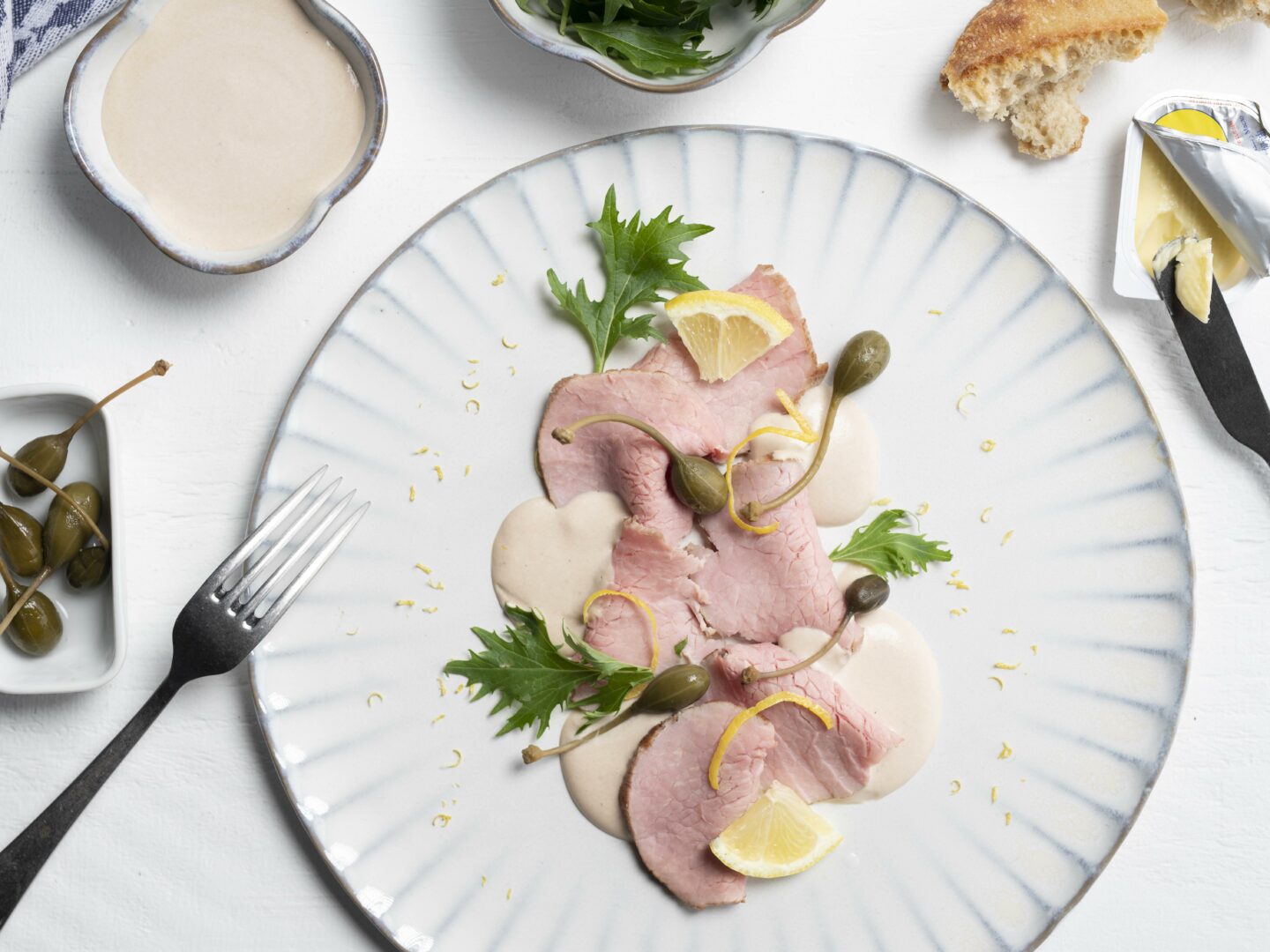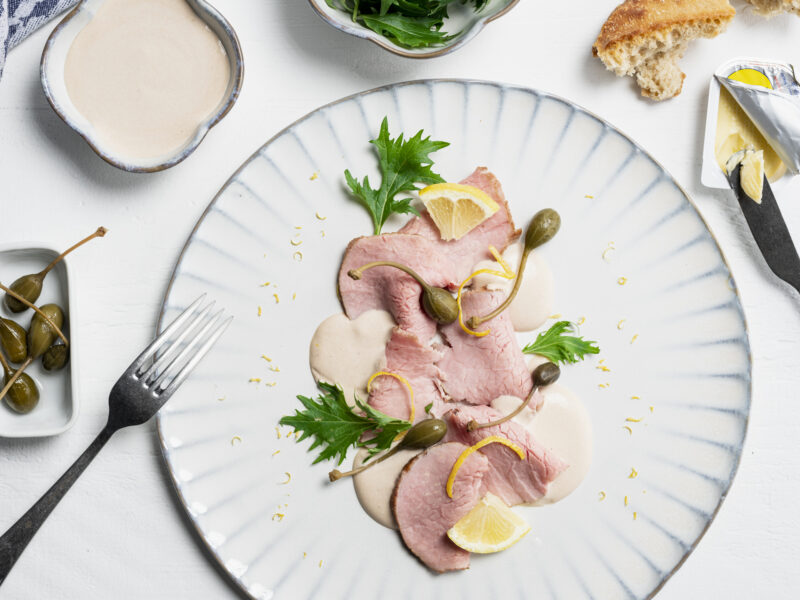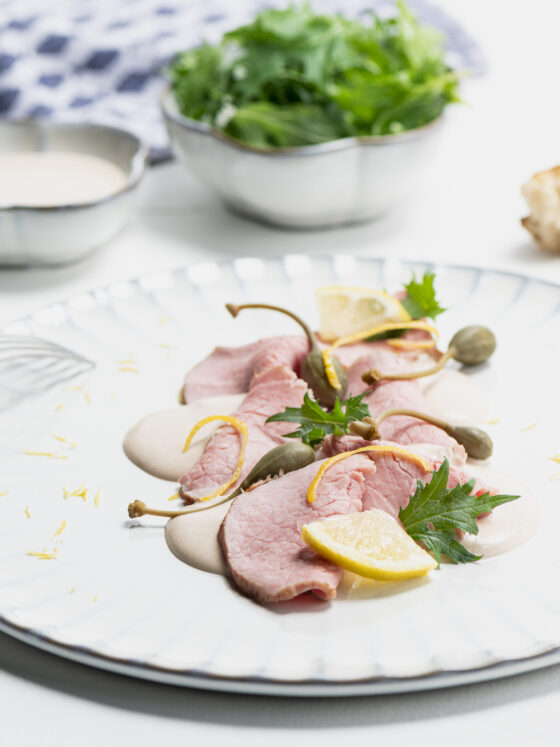Italian cuisine: 2 x vitello tonnato
La bella Italia, who doesn't love it? I often think about the years I spent with my family in northern Italy. Fausta, my Italian teacher, and I could talk for hours about what makes Italian food so typical. No better way to learn the language! One day Fausta brought me a recipe for one of Italy's most beloved dishes: vitello tonnato. Not only will I share my preparation of vitello tonnato in this blog; I'm also happy to reveal Fausta's family recipe to you.

What is vitello tonnato?
Vitello tonnato is actually veal with tuna. At first glance, this is a bizarre combination of flavors, but this dish is so delicious! The aromatic veal is cut into very thin slices and then topped with a creamy tuna-based sauce. The dish is finished with capers and served as an antipasto or light lunch.
Vitello tonnato is best prepared with a lean piece of veal
The most important element in successfully making vitello tonnato is, of course, the piece of veal. My butcher in Italy, Signor Piran, always asked what dish I wanted to prepare and then presented me with the perfect piece of meat. For vitello tonnato, he swore by magatello di vitello: a tender, lean piece from the calf's topside, without nerves or tendons. It has only a short cooking time. Here we know that piece as the eye of round.

Did you know that ...
Did you know that vitello tonnato originated around the 18e century? Back then, people prepared veal as if it were tuna. Later, anchovies and olive oil were added. Still later, a Milanese doctor came up with the idea of skipping the olive oil, cooking the meat and finally serving it with pieces of tuna and anchovies. We owe the recipe for vitello tonnato as we eat it today to Roman gastronomic genius Pellegrino Artusi. He published it in 1891 in his Scienza in cucina et l'arte di mangiar bene. Mastering that art of eating: Italians are masters at it!
Eat, pray, love in Italy
Food is an important part of Italian culture. It really is a family event: shopping, cooking, eating together and chatting at the table for hours afterwards. And the Italians know all about quality. Both in the supermarket and at the market, every vegetable, piece of cheese, fish or piece of meat is inspected in detail before it is purchased. Nonnas as well as mothers with children and young couples come with shopping bags full of fresh products from the market. The narrow streets smell of garlic and fresh herbs and every dish is finger-licking delicious. Yes, Italian cooking stole my heart ... When are we off?
Preparation 1: Ingredients for vitello tonnato cooked at low temperature
For the meat:
- 900 g veal eye of round
- 1 shallot
- 1 branch green celery
- 2 sprigs parsley
- 2 bay leaves
- 10 cloves
- Freshly ground pepper
- Ziplock bag
For the sauce:
- 200 g tuna in olive oil
- 4 anchovy fillets in olive oil
- 1.5 tablespoons capers and 1 additional tablespoon for finishing
- 75 g mayonnaise
- 2 tablespoons chicken or vegetable broth
- 1 tablespoon lemon juice
- Pepper and salt
- 25 ml cream
Preparation 2: Fausta's vitello tonnato
For the meat:
- 900 g veal eye of round
- 2 carrots
- 1 onion
- 2 branches of green celery
- 10 cloves
- 10 peppercorns
- 5 sprigs Italian parsley
- 2 bay leaves
- 1 tablespoon olive oil
- 1 tablespoon balsamic vinegar
- 1 pinch coarse sea salt
For the sauce:
- 200 g tuna in olive oil
- 4 anchovy fillets in olive oil
- 1.5 tablespoons capers and an extra tablespoon for finishing
- 3 boiled eggs
- 75 ml chicken or vegetable broth
- 2 tablespoons lemon juice
- Pepper and salt
- 50 to 75 ml cream
-
Preparation 1: vitello tonnato cooked at low temperature
If you want to keep the meat tender , you need to respect its cooling and resting times. That's why I first vacuum pack and then cook the meat at low temperature. While the meat cooks and rests, I make the sauce.
Start with the meat
With a pointed knife, make indentations in the veal and fill the holes with cloves. Then peel the shallot, cut it in half and take apart all the bulb skirts. Rinse the fresh herbs and season the meat with pepper only.
Next, place the meat in the Ziplock bag, and spread the shallot and herbs on both sides. Pull the bag vacuum.
Cook the meat in a hot water bath at 57°C for two hours. Then remove the package from the water and let it cool unopened. Then place the package in the refrigerator.
Salsa tonnata with mayonnaise
Start by draining the tuna. Then add it along with the anchovies, capers and mayonnaise in a high-speed blender. Start slow and gradually add in the broth and lemon juice. Then run it at full speed until you get a smooth sauce.
In a separate cup, whisk the cream. Gently stir it under the tuna sauce. The result should be a creamy sauce. Is the sauce still too thick? Add a little more broth. Finally, season the sauce with the lemon juice and salt and pepper. Does your sauce seem too runny? Don’t worry, during the resting period in the refrigerator, the sauce solidifies.
Finishing
We're almost there! Remove the chilled meat from the vacuum bag and rub the piece dry. Cut the meat into very fine slices. You can use an electric slicer to do this. Take out your most Italian dish, arrange the slices of meat on it and top with the tuna sauce. Place the dish in the refrigerator for several hours so that the flavors blend.
Half an hour before serving, remove the dish from the refrigerator. Decorate the vitello tonnato with some capers and a few thin slices of lemon. Serve it with a fresh, green salad, and you will immediately imagine yourself in sunny Italy!
![SG 3 vitello tonato]()
-
Preparation 2: Fausta's vitello tonnato
Start with the meat
With a pointed knife, make indentations in the veal and fill the holes with cloves. Fill a stockpot with water and add all the other ingredients, as well as the meat. Put the lid on the saucepan and simmer the meat for about 35 minutes. Let the meat cool in the broth.
Prepare the tuna sauce
To prepare Fausta's sauce, first drain the tuna. Then mix it together with the anchovies, capers and boiled eggs in a high-speed blender. Starting slow, add in the broth and lemon juice. Then run everything at full speed until you get a fairly liquid sauce.
Next, in another cup, whisk the cream. Then gently stir the cream under the tuna sauce. The end result should be creamy. If your sauce is too solid, add some extra broth. Finally, season the tuna sauce with salt and pepper.
Finishing
Remove the meat from the broth and rub the piece dry. Then proceed as mentioned above in my preparation at low temperature.
![SG 2 vitello tonato]()

